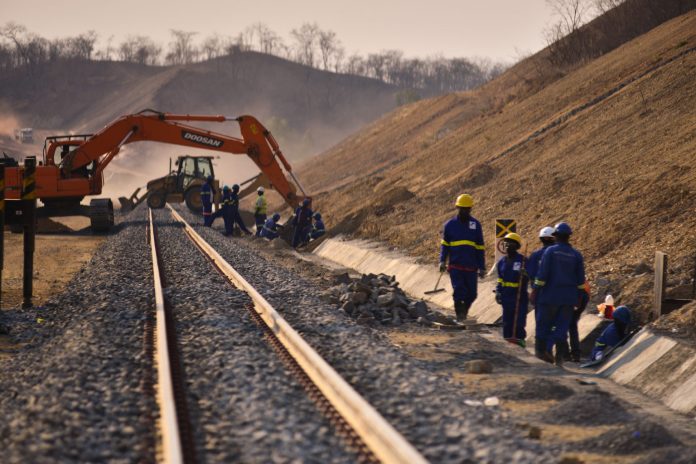Angola is seeking $4.5 billion to finance a strategic rail connection from its Atlantic coastline to Zambia’s Copperbelt, a move set to reshape regional trade, mineral supply chains, and the continent’s green industrial future. The project, a key extension of the Lobito Corridor, aims to directly connect Zambia’s copper mines to the deep-water Port of Lobito, creating a shorter, more efficient export route that bypasses congested southern transit lines.
Already, Italy has committed $320 million and the African Development Bank $500 million, while Angola’s Transport Minister Ricardo Viegas d’Abreu confirmed interest from Egypt and exploratory discussions with the European Union. The Africa Finance Corporation, which currently oversees the concession, will finalize cost projections as it advances tendering in the coming months. Construction is expected to begin next year.
This corridor is not just about rail; it is about unlocking the economic geography of Southern and Central Africa. Today, Zambia and neighboring Democratic Republic of Congo, together producing over 15% of the world’s copper, rely heavily on road and rail routes stretching hundreds of kilometers south to ports in South Africa, Mozambique, and Tanzania. Congestion, border delays, and aging infrastructure mean that copper, cobalt, and manganese often take three to four weeks to reach global markets.
The Lobito route aims to cut that journey by more than half, driving down transport costs and strengthening Africa’s bargaining position in the global energy transition. Copper is indispensable for electric vehicles, renewable power systems, and battery technologies. As demand surges, with global analysts projecting needs to nearly double by 2035, Africa’s mineral-rich economies are vying not only to export ore but to capture more value through refining and manufacturing.
Read also: From dialogue to deals: Africa Climate Investment Summit 2025 paves way for scalable climate finance
For Zambia, the planned 800-kilometer connection is poised to be the largest rail investment since the 1970s, when China financed the TAZARA Railway to Dar es Salaam. Its Copperbelt region, responsible for more than 70% of Zambia’s export revenue, seeks infrastructure capable of supporting increasing production targets as new mines open. Angola, meanwhile, envisions becoming a logistics gateway for central Africa, transforming decades of post-war rebuild into modern commercial leverage.
Financing tells a revealing story. The United States once championed the Lobito corridor under an initiative to counterbalance China’s infrastructure influence, approving a $553 million loan in 2024 for the Angolan section. The funds, however, have been slow to disburse, underscoring global competition and hesitation in large-scale African infrastructure backing. For host nations, this delay translates into lost time amid a rapidly evolving critical-minerals economy.
Angola’s renewed push has therefore broadened the donor circle. European institutions increasingly view the Lobito link as vital to supply chain diversification, especially as geopolitical risks shake commodity dependences elsewhere. Egypt’s interest signals growing intra-African financial diplomacy, part of a wider continental movement to build infrastructure that serves African rather than exclusively external logistics patterns.
The scale of the project is matched by its sustainability implications. A fully operational Lobito Corridor rail system could remove tens of thousands of fuel-heavy truck journeys off roads annually, slashing transport emissions and easing degradation along trade routes. By strengthening rail as the backbone for mineral and agricultural flows, including maize, fertilizer, and manufactured goods, Angola and Zambia are pushing toward lower-carbon logistics while reducing trade vulnerability to volatile fuel markets.
Still, practical challenges remain. Angola must ensure transparent procurement, resilient management, and capacity to operate a network spanning multiple jurisdictions and corporate stakeholders. Zambia, equally, must align mine expansion with predictable freight volumes to keep financial models viable. And both nations face the question of how to ensure that improved transport does not result only in accelerated ore extraction, but leads to local industrialization, jobs, and economic diversification.
Read also: Morocco charts 2040 Coal exit in bold move towards Africa’s green energy future
Where past megaprojects promised transformation but delivered uneven gains, Angola’s government is framing the Lobito extension as a continental trade artery, not a single-country asset. If the funding is secured and timelines hold, trains could begin rolling before the decade is out, carrying minerals that power the clean-energy future and demonstrating Africa’s capability to architect its own infrastructure destiny.
The success of this deal could determine more than cargo routes . It could signal that African economies are finally securing capital not just for raw resource extraction, but for the systems that bind the continent to the world economy on its own terms.






